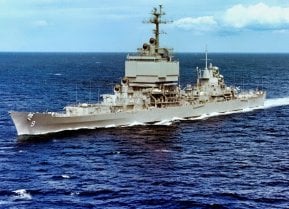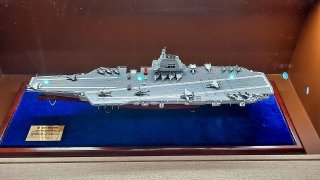China Could Have Its Own Aircraft Carrier-Based 'Eye in the Sky'
There has been no evidence—photo, video, satellite—to suggest that the KJ-600 has undergone catapult launch or arrested recovery, but such testing could have been conducted in secret at the PLAN Carrier Aviation Test and Training Base.
Modern carrier-based fighter aircraft continue to get their more than fair share of the limelight—with the F-14 Tomcat, F/A-18 Super Hornet, and F-35C Lightning II each being practically famous. But they couldn't do what they do so well were it not for the Northrop Grumman E-2 Hawkeye, the all-weather, tactical airborne early warning (AEW) aircraft.
The twin-turboprop aircraft was designed and developed during the late 1950s and early 1960s, first entering service in 1964. Even six decades later, it continues to serve as a United States Navy carrier strike group's (CSG) eye in the sky. For much of its service life, no other aircraft could do what the E-2 Hawkeye could—but soon the People's Liberation Army Navy (PLAN) could be operating its own version, the Xi'an KJ-600.
This week, Flight Global first reported that images on Chinese social media purported to show a KJ-600 conducting test flights, with the aircraft sporting a gray paint scheme. Though it is unknown exactly when or even where the images were taken, it was noted by the aviation trade news outlet that the Chinese AEW aircraft bears a resemblance to the E-2 Hawkeye, including the American plane's four-fin tail.
It is unclear how many KJ-600s have been built, but it is believed that at least six prototypes are in the testing stage.
The early warning aircraft is reported to be equipped with an active electronically scanned array (AESA), which Chinese aviation experts have claimed could be employed to spot and track stealth aircraft including the U.S. military's F-22 Raptor and F-35 Lightning II, as well as the Russian Su-57. The radar can further be used to detect marine targets and to provide coordinates in three dimensions.
The KJ-600 also is believed to be operated by a crew of five to six—including the pilot, co-pilot, and aircrew who operate the radar and combat control systems.
Is It Carrier Capable?
There has been no evidence—photo, video, satellite—to suggest that the KJ-600 has undergone catapult launch or arrested recovery, but such testing could have been conducted in secret at the PLAN Carrier Aviation Test and Training Base. It would seem logical that the PLAN intends to operate the KJ-600 from the Type 003 Fujian, which is equipped with a trio of electromagnetic launch systems (EMALS) to launch a broad range of aircraft. Progress on China's newest carrier continues, and it is expected that it could begin its sea trials later this year.
It is highly unlikely that the KJ-600 could operate from Beijing's current carriers, the Type 001 Liaoning or the Type 002 Shandong, as those warships employ ski-jumps to launch aircraft. So, it now appears that the capabilities of the Type 003 Fujian could be greatly enhanced with the AEW aircraft.
Military analysts have suggested that the KJ-600 could allow the Chinese to surpass the United States in some capabilities, thanks to the Chinese military's efforts to develop data linking technology, which could allow AEW planes to guide other aircraft as well as help target long-range missiles.
In addition, there has been speculation that a carrier onboard delivery KJ-600 variant is being developed as well. It could fill a similar role as the U.S. Navy's C-2 Greyhound to ferry important equipment and personnel between land and the carrier.
Author Experience and Expertise: Peter Suciu
Peter Suciu is a Michigan-based writer. He has contributed to more than four dozen magazines, newspapers, and websites with over 3,200 published pieces over a twenty-year career in journalism. He regularly writes about military hardware, firearms history, cybersecurity, politics, and international affairs. Peter is also a Contributing Writer for Forbes and Clearance Jobs. You can follow him on Twitter: @PeterSuciu. You can email the author: [email protected].


